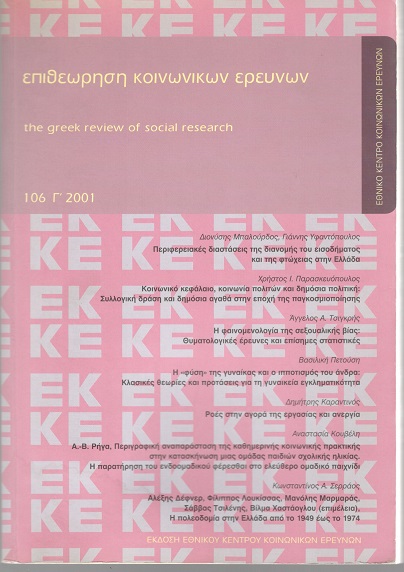Η "φύση" της γυναίκας και ο ιπποτισμός του άνδρα: Κλασικές θεωρίες και προτάσεις για τη γυναικεία εγκληματικότητα
Abstract
Διάφορες εγκληματολογικές προσεγγίσεις που κατά καιρούς εστίασαν στη γυναικεία
εγκληματικότητα προσέδωσαν στο φαινόμενο κάποιο βαθμό «ανωμαλίας» και, σε μεγάλη έκταση, στήριξαν τις ερμηνείες τους σε αναπόδεικτες, σεξιστικές υποθέσεις αναφορικά με τη «φύση» των γυναικών και τον «ιπποτισμό» των ανδρών. Η βάση αυτών των υποθέσεων βρίσκεται στις λεγόμενες «κλασικές» ερμηνείες της γυναικείας εγκληματικότητας οι οποίες επηρέασαν σημαντικά μεταγενέστερες ερμηνείες του φαινομένου. Στην παρούσα μελέτη παρουσιάζονται οι «κλασικές » θεωρητικές ερμηνείες της γυναικείας εγκληματικότητας όπως αναπτύχθηκαν από τους Lombroso, Ferrerò, W.I. Thomas, Otto Pollak. Η ανάλυση των προτάσεων τους γίνεται με βάση τις θέσεις του φεμινιστικού εγκληματολογικού παραδείγματος.
Article Details
- How to Cite
-
Πετούση Β. (2001). Η "φύση" της γυναίκας και ο ιπποτισμός του άνδρα: Κλασικές θεωρίες και προτάσεις για τη γυναικεία εγκληματικότητα. The Greek Review of Social Research, 106, 105–137. https://doi.org/10.12681/grsr.8854
- Issue
- 2001: 106 Γ'
- Section
- Articles

This work is licensed under a Creative Commons Attribution-NonCommercial 4.0 International License.
Authors who publish with this journal agree to the following terms:
- Authors retain copyright and grant the journal right of first publication with the work simultaneously licensed under a Creative Commons Attribution Non-Commercial License that allows others to share the work with an acknowledgement of the work's authorship and initial publication in this journal.
- Authors are able to enter into separate, additional contractual arrangements for the non-exclusive distribution of the journal's published version of the work (e.g. post it to an institutional repository or publish it in a book), with an acknowledgement of its initial publication in this journal.
- Authors are permitted and encouraged to post their work online (preferably in institutional repositories or on their website) prior to and during the submission process, as it can lead to productive exchanges, as well as earlier and greater citation of published work (See The Effect of Open Access).



